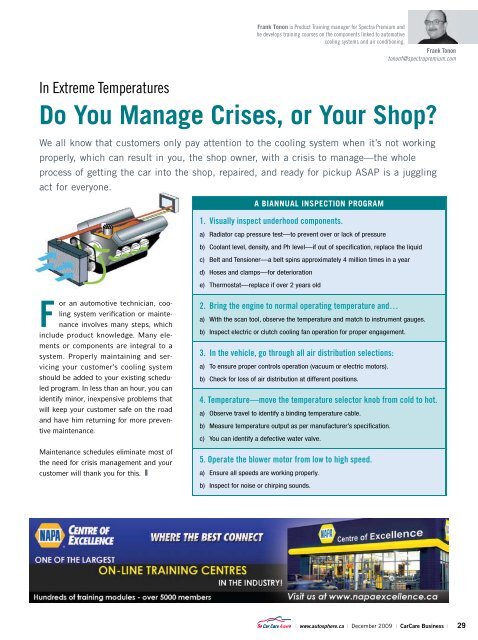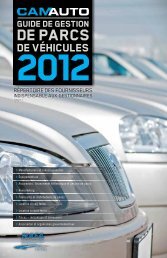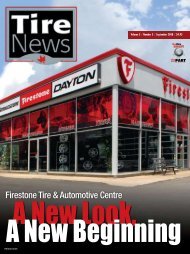Eastern Automotive Warehousing/Auto Machinery - Autosphere
Eastern Automotive Warehousing/Auto Machinery - Autosphere
Eastern Automotive Warehousing/Auto Machinery - Autosphere
Create successful ePaper yourself
Turn your PDF publications into a flip-book with our unique Google optimized e-Paper software.
In Extreme Temperatures<br />
Do You Manage Crises, or Your Shop?<br />
We all know that customers only pay attention to the cooling system when it’s not working<br />
properly, which can result in you, the shop owner, with a crisis to manage—the whole<br />
process of getting the car into the shop, repaired, and ready for pickup ASAP is a juggling<br />
act for everyone.<br />
For an automotive technician, cooling<br />
system verifi cation or maintenance<br />
involves many steps, which<br />
include product knowledge. Many elements<br />
or components are integral to a<br />
system. Properly maintaining and servicing<br />
your customer’s cooling system<br />
should be added to your existing scheduled<br />
program. In less than an hour, you can<br />
identify minor, inexpensive problems that<br />
will keep your customer safe on the road<br />
and have him returning for more preventive<br />
maintenance.<br />
Maintenance schedules eliminate most of<br />
the need for crisis management and your<br />
customer will thank you for this.<br />
Frank Tonon is Product Training manager for Spectra Premium and<br />
he develops training courses on the components linked to automotive<br />
cooling systems and air conditioning.<br />
Frank Tonon<br />
tononf@spectrapremium.com<br />
A BIANNUAL INSPECTION PROGRAM<br />
1. Visually inspect underhood components.<br />
a) Radiator cap pressure test—to prevent over or lack of pressure<br />
b) Coolant level, density, and Ph level—if out of specifi cation, replace the liquid<br />
c) Belt and Tensioner—a belt spins approximately 4 million times in a year<br />
d) Hoses and clamps—for deterioration<br />
e) Thermostat—replace if over 2 years old<br />
2. Bring the engine to normal operating temperature and…<br />
a) With the scan tool, observe the temperature and match to instrument gauges.<br />
b) Inspect electric or clutch cooling fan operation for proper engagement.<br />
3. In the vehicle, go through all air distribution selections:<br />
a) To ensure proper controls operation (vacuum or electric motors).<br />
b) Check for loss of air distribution at different positions.<br />
4. Temperature—move the temperature selector knob from cold to hot.<br />
a) Observe travel to identify a binding temperature cable.<br />
b) Measure temperature output as per manufacturer’s specifi cation.<br />
c) You can identify a defective water valve.<br />
5. Operate the blower motor from low to high speed.<br />
a) Ensure all speeds are working properly.<br />
b) Inspect for noise or chirping sounds.<br />
| www.autosphere.ca | December 2009 | CarCare Business | 29












